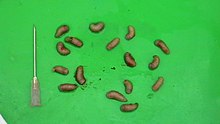| Gasterophilus haemorrhoidalis | |
|---|---|

| |
| Scientific classification | |
| Domain: | Eukaryota |
| Kingdom: | Animalia |
| Phylum: | Arthropoda |
| Class: | Insecta |
| Order: | Diptera |
| Family: | Oestridae |
| Genus: | Gasterophilus |
| Species: | G. haemorrhoidalis |
| Binomial name | |
| Gasterophilus haemorrhoidalis (Linnaeus, 1758) | |
| Synonyms | |

Gasterophilus haemorrhoidalis (also called nose botfly or lip botfly) is a species of the genus Gasterophilus that lays eggs on the lips and around the mouth of horses, mules and donkeys. Their hatching is simulated by moisture from licking or feeding of hosts.
First instar development: Penetrate epidermis of the lips of hosts and migrate into mouth.
Second instar: move to stomach and duodenum(first section of small intestine)
Third instar: larvae become detached after some time and then pass to the rectum and re-attach themselves.
Appearance: Postsutural scutum with ground color uniformly brown or black legs yellowish brown, with femora distinctly darkened; abdomen ground color dark brown or black, with reddish-yellow or orangish setae posteriorl. Males possess a surstylus that abruptly tapers distally, with short surstylar setae that reach at most halfway to the sagittal plane. Regarding egg description, the pedicel is long and slender, with a width/length ratio of approximately 1/6 in lateral view, comprising 2/5 of the total egg length.
Egg Description: Pedicel long and slender, with width/length ratio around 1/6 in lateral view, accounting for 2/5 of the total egg length.
In Equidae, third-stage larvae attach to the stomach, but also to the rectum, sometimes in great numbers. Heavy infestation can cause anal prolapse in foals and mules.
They do not parasitise humans.
References
- Johannes Kaufmann, Parasitic Infections of Domestic Animals, Birkhäuser Verlag, Basel, Boston, Berlin, 1996, ISBN 3-7643-5115-2.
2. Li XY, Pape T, Zhang D. Taxonomic review of Gasterophilus (Oestridae, Gasterophilinae) of the world, with updated nomenclature, keys, biological notes, and distributions. Zookeys. 2019 Nov 21;891:119-156. doi: 10.3897/zookeys.891.38560. PMID 31802974; PMCID: PMC6882926.
External links
| Taxon identifiers | |
|---|---|
| Gasterophilus haemorrhoidalis |
|
This article related to members of the muscomorph flies superfamily Oestroidea is a stub. You can help Misplaced Pages by expanding it. |
This veterinary medicine–related article is a stub. You can help Misplaced Pages by expanding it. |
This parasitic insect-related article is a stub. You can help Misplaced Pages by expanding it. |